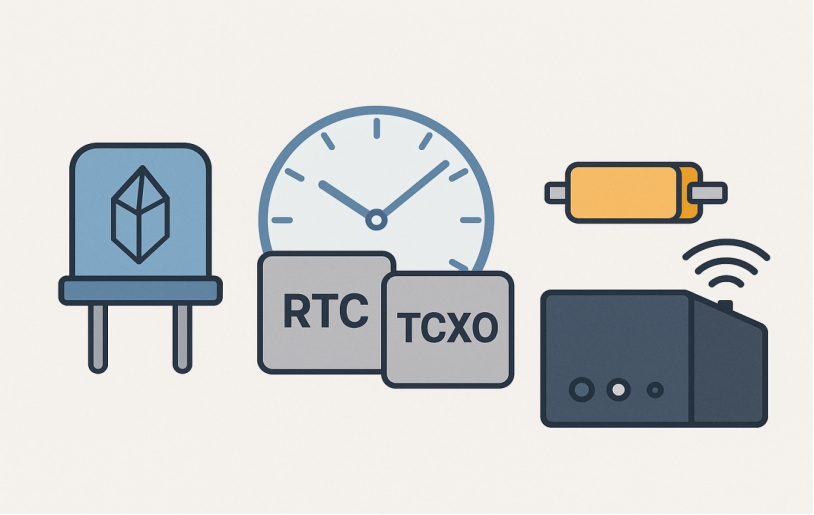How Does the Crystal Oscillator Maintain Stable Frequency?
In an era of distributed computing and smart devices, edge processing is rapidly gaining momentum. As workloads shift from centralized data centers to edge nodes, maintaining reliable and precise timing becomes paramount. One of the foundational components ensuring this precision is the crystal oscillator, a small yet vital element responsible for generating stable frequency signals.

Precision Timing in Edge Nodes: Why It Matters
Edge nodes often function autonomously or semi-autonomously, handling tasks like data filtering, event detection, and preliminary analytics before forwarding information to the cloud. These decentralized systems must operate in tight synchronization with one another—whether for load balancing, sensor fusion, or time-stamped event coordination.
The accuracy of local clocks directly impacts the response speed and coherence of the entire network. Even minor timing discrepancies can lead to data loss, processing delays, or misaligned decision-making in time-sensitive systems. For example, in an autonomous vehicle or an industrial automation setup, asynchronous behavior across modules may introduce safety risks or lower operational efficiency.
This is where low-phase-noise crystal oscillators come into play. They generate clean, precise clock signals that serve as the timing backbone of microcontrollers and processors within edge devices.
RTC and TCXO: Stable Timing for Remote and Offline Applications
In locations without continuous internet access or GPS signals—such as remote environmental monitoring stations, IoT-enabled agriculture systems, or military-grade communication units—maintaining an accurate internal clock becomes more challenging.
Real-Time Clock (RTC) crystals are commonly used in these cases to track time with minimal power consumption. These oscillators often work alongside a backup power supply to preserve timing data even when the main system is shut down. Although RTCs typically offer modest accuracy, their ultra-low power design makes them ideal for battery-operated and solar-powered edge applications.
For more timing-sensitive applications in temperature-variable environments, Temperature-Compensated Crystal Oscillators (TCXOs) offer a critical advantage. Unlike standard oscillators that may drift due to thermal fluctuations, TCXOs integrate a temperature sensor and compensation circuit, ensuring stable output frequency across a wide range of operating temperatures. This feature is especially valuable in outdoor equipment, transportation systems, and aerospace technology.

Miniaturization and High Frequency: Enabling Advanced Edge Applications
As edge devices shrink in size and increase in complexity, the demand for compact, high-frequency oscillators has surged. These components must fit within constrained PCB real estate while offering the same—if not better—frequency stability and performance as their larger predecessors.
Miniaturized SMD (Surface-Mount Device) crystal oscillators, such as those in the 2016 or 1612 packages, are increasingly adopted in wearable electronics, smart sensors, and portable medical equipment. Their high operating frequencies (ranging from 20 MHz to hundreds of MHz) support high-speed data processing and communication protocols like Bluetooth Low Energy (BLE), Wi-Fi, and LTE-M.
Moreover, higher frequencies allow for more refined timing resolution, which is essential for edge AI workloads, video streaming, and real-time data encryption.
Applications Across Industry Domains
Crystal oscillators in edge environments are not confined to a single vertical. In smart manufacturing, they regulate motion control systems and robotic arms with millisecond-level precision. In telecommunication, small-form TCXOs ensure cellular base stations and repeaters maintain signal integrity. Even in healthcare, portable diagnostic devices rely on micro crystal oscillators to deliver accurate results and continuous patient monitoring.
As computing shifts closer to where data is generated, timing precision becomes non-negotiable. Crystal oscillators—particularly RTC and TCXO models—play a vital role in ensuring synchronized operations in remote and edge environments. Their contribution is amplified when combined with miniaturized form factors and high-frequency performance, allowing edge hardware to be both compact and powerful.
In this evolving ecosystem, choosing the right oscillator is not merely a design decision—it is a foundational requirement for maintaining operational stability, energy efficiency, and long-term reliability.We can provide you with the most professional and suitable solutions for your professional needs of crystal oscillators. For details, please contact us at ivy@jghcrystal.com and we will contact you within 24 hours.
Prev: What are the advantages of Infrared vein finder with Table Stand?